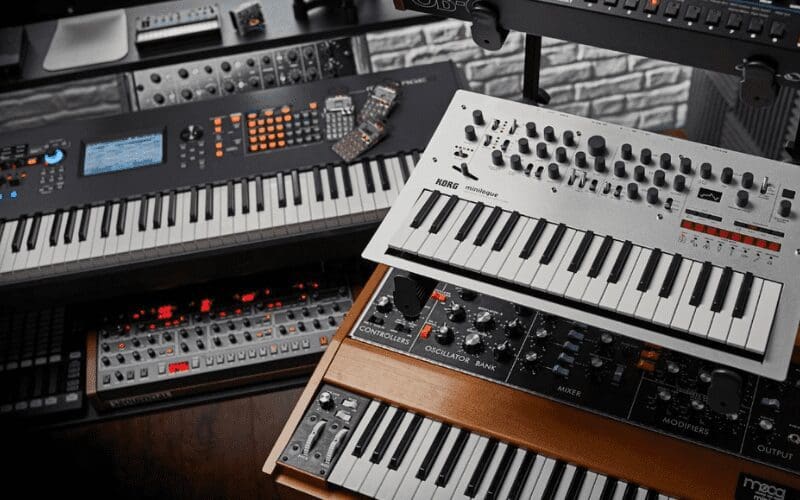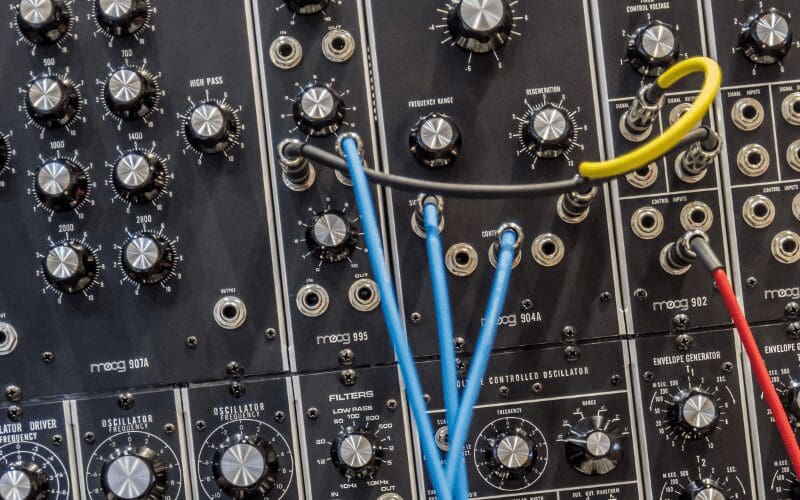What is a synthesizer? Well, without it, modern music as we know it just wouldn’t exist. Half of the greatest songs of the 1980s wouldn’t have happened (I mean, what would Europe’s ‘The Final Countdown’ even be like without that Synth hook?!?!).

There are very early examples of music synthesizer dating all the way back to the 1920s. But, they really started to play a part in music after Synth’s godfather Robert Moog.
He started selling his Prototype Synths in the mid-1960s. With rapid expansion in the 1970s and 1980s.
What Is A Synthezier?
Synthesizers are machines that electronically generate and modify sounds, frequently with the use of a digital computer.
Synthesizers are used for the composition of electronic music and live performances.
They are the most modest musical instruments you can imagine. They look like small and rather mundane electronic pianos. But, they’re actually much more than that.
Let’s get into why creatives may find synths useful.
Why Use A Synth?

For many artists, a synth is an incredible tool. From atmospheric pads to face-melting lead lines, fat basslines to weird noises. You can literally make any sound come to life with a synth.
But for many (myself included) – that’s the rub.
Knowing how to operate a synth properly is like learning a whole new language. In fact, it would appear that to really get the most out of a sound synthesizer you might need a degree in physics, electrical engineering, and music. So there is often a huge learning curve involved in getting the sounds you are looking for.
My Dad is a seasoned keys session musician player. So, growing up, there was no shortage of pianos, electronic musical instruments like keyboards, and various synths lying around the house.
I didn’t know it at the time, but mucking around with his Roland SH-101 was something I should have perhaps treasured more. As they are now pretty highly regarded by people who know anything about synths.
I could never really wrap my head around this electronic instruments world. With words like Oscillator, LFO, and Envelope – prefer instead to stick to a guitar.
But, the lure of the synth is strong and I couldn’t help but delve into this world and try to make sense of it!
As a note, there are tons of different kinds of modular synthesizers in the market. Although I have covered general elements of a Synth that appear on pretty much all models.
I have chosen to base this blog on the Moog Sub Phatty. which is a good beginner’s synth but the principles I talk about apply to all synths.
Types Of Music Synthesizers
The first thing I learned when I started looking at this was that there are tons of different types. Analog, Digital, Mono, Poly, and of course Virtual.
The classic synths are all analogue. The sound is made by old-fashioned sound-generating circuitry. Which creates a sound wave that you then manipulate through the use of filters and envelopes (Stay with me!!! We’ll come back to waves and manipulation shortly!).
Digital Synths

A digital synthesizer uses digital processors. They are in essence a computer with a piano keyboard and typically some kind of LCD as an interface.
Since the birth of Modern DAWs (Digital Audio Workstations – recording software like Logic Pro X or Pro Tools) – VST Plugins that allow producers to access a world of different synth sounds.
Try out Xfer Serum VST for example!
VST Synths

VST Synths are very similar to Digital Synths in how they work. But of course with the added bonus of using MIDI so you can change the sound later and experiment with all sorts of different sounds.
As with all things analogue vs digital. There is a general perception that analogue sound is best and for me, the analogue instruments in my studio are my favourites.
However, I am yet to produce anything that has used exclusively analogue. The VST and Digital synths will always have a space in the recording studio and give any producer/recording artist multiple options.
Digital and VST synthesizers are generally much cheaper than their analogue counterparts. In truth, these days the sound is pretty close to the originals – but don’t argue with any purists out there!
Mono & Poly Synths

Beyond that, you have Mono and Poly Synths. The old Synths were generally all Mono (short for monophonic). They played one sound at a time – and required quite a chunk of complex circuitry to achieve that one sound.
Whereas digital synths are often simpler (because they have a number of digital processors). So in any case they can support multiple notes at the same time, making them Polyphonic.
How To Use A Synth

The key to understanding how to use a synthesizer is underpinned by understanding how a synth works.
Acoustic instruments produce sound through vibration. A guitar string is plucked and that vibrating string moves the air molecules around it to create the sound. Creating a simple wave that is looked at individually is called a Sine wave.
But, there’s more to the picture. The reason a C on the flute instrumental sounds different to a C on the violin is that they have different timbres.
Timbre is how different resonant high frequencies are sounded at different levels when a note is played. If you view those frequencies all as one wave, you get different, more complex waves with audible characteristics as well as additive synthesis and subtractive synthesis.
The Oscillator

Instead of creating sound acoustically using vibration, synths generate electrical signals that are amplified and converted to sound through voltage controlled oscillators. This electrical signal is generated by the Synth’s Oscillator.
The Oscillator’s waveform can be a simple Sine wave. Or you can also choose Triangle, Sawtooth, Square, and Pulse waves.
Triangle waves consist of odd-numbered harmonics only. So it’s quite a simple sound with a strong overriding note.
A Sawtooth wave is much brighter because you also get all the harmonics. As they grow weaker in amplitude, they can be good for making fat bass sounds and brassy tones.
Pulse waves are kind of similar to Triangle waves because they only have odd-numbered harmonics. But you can change the balance of the odd-numbered harmonics so it offers loads of flexibility in terms of making sounds.
A square wave is the same as a pulse wave. But the pulse width is 50% less so each pulse in the wave has a unique sound. These waves have a kind of natural single-note arpeggiator sound, but each note has a slightly different sound.
A lot of synths also have a 2nd Oscillator which you can either run in parallel with your 1st Oscillator. Or, you can assign a different waveform to it or even de-tune the second note the thicken up the sound.
The Filter

Your Oscillator’s signal then flows through a Filter. The Filter removes certain frequencies from audio and alters the waveform to further affect the sound.
The Filter is a low pass (allowing low frequencies to be heard) made up of a Cutoff dial. Which allows you to set where the Low-Pass filter kicks in.
There is also a Resonance setting that controls how much signal is routed from the high pass filter’s output back to its input.
Generally, once you get to the higher levels of this setting, you can also get your synth to start to self-oscillate. Which is pretty cool for making soundscapes and atmospheric pads, etc.
The Envelope

From the filter, the Oscillator’s wave then flows through the Envelope. The envelope is where you really get into the nuts and bolts of sound design.
Synths have 4 main controls in the envelope – attack, decay, sustain and release.
- Attack (how quickly a sound reaches its full strength and brightness)
- Decay (how quickly the sound declines after the initial attack)
- Sustain (how long the note lasts)
- Release (how long the note takes to return to silence once the key is lifted), often abbreviated to ADSR envelope.
Some synths have only one set of envelope controls whilst others have 2. One for the Filter and then a 2nd envelope for the Amplifier.
The Filter Envelope will control the timbre of a sound whilst the Amplifier envelope controls the amplitude (or strength) of the sound.
Modulation

Controlling Modulation (often abbreviated to Mod) is an important aspect of how the sound is shaped.
When you modulate a control signal, you effectively change something about the effect your control signal has on the wave from the Oscillator.
You can modulate things like Pitch, filter cutoff and even the waveform to shape the sound. You can often control the Modulation signal’s depth using a wheel or slider next to the keyboard called a Modwheel.
The Modulation panel often includes an LFO (Low-Frequency Oscillator). Which mirrors the waveform in the sub-audio range and gives some additional beef to your signal. Or you can increase the LFO range to the audible range to add some harmonic depth to what you’re doing.
The LFO Rate dial controls the rate of modulation on the LFO. Which adds some really interesting effects.
If you’re working with Analogue synths especially, the Modulation Panel is a good place to look if your notes sound out of tune.
Analog synthesizers all have their own little quirks. Especially some of the older synths have pitch adjustments as they warm up. So you often have a pitch adjustment knob to help make sure your note is in tune.
Mixer

The Mixer looks different from Synth to Synth but generally, you have your Oscillator and Sub-Oscillator balance and if you have a 2nd Oscillator a control for that is also there. You also have a noise generator.
As you would expect, this is essentially just a level of white noise that is overlaid on your sound. It’s particularly useful if you’re looking to mimic percussive drum sounds, spacey wind effects or just a noisy bass line.
What Is A Synthesizer? Our Final Thoughts

Hopefully, this will give some insight into how a synthesizer works and how to use it.
That said, my Dad’s advice is probably the best approach. Just play with the thing until you know how it works. Enjoy!
Now you have learned about how synthesizers work, you will hopefully be utilising your new skills when producing music! Allow us to help you amplify your music, collaborate with others, music promotion and marketing – even get your music in TV, film and more. Why not try Мusic Gateway for free?



